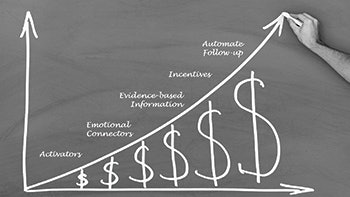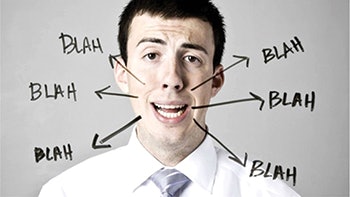
As we discussed last month, there may be 12 company crushing killers roaming loose inside your business right now — we call them the Deadly Dozen — and they're costing you a lot of money in lost opportunity and lost business.
Last time we talked about overused platitudes, fragmented marketing and failing to use hot-button advertising. Today we'll get into the guts of your marketing plan.
RELATED: 12 Company-Crushing Killers – Part 1

COMPANY KILLER #4 - NOT USING VIDEO STRATEGICALLY
The explosive growth of online video is remarkable. YouTube was founded on February 14, 2005. Now, barely 12 years later, almost 5 BILLION YouTube videos are watched EVERY SINGLE DAY.
Granted, there's no shortage of funny cat videos and local news bloopers, but top marketers embrace video as a best practice and it's now ranked as the most effective form of content marketing. If you aren't using video advertising effectively, you've invited this enemy right into your boardroom.
Check out these stats:
- Businesses using video grow company revenue 49% faster than organizations without video.
- Social video generates 1,200% more shares than text and images combined.
- 70% of marketers say video produces more conversions than any other type of content.
- Companies using video enjoy 41% more web traffic from searches than non-users.
- Facebook gives video content priority in its news feed.
- Only 28% of website content is read on average.
- 59% of C-suite execs prefer watching video to reading text on a page.
- E-commerce customers are 50% more confident of their purchase after watching a product video, and cart contents can increase up to 174%.
- 40% of consumers say video increases the chance they'll purchase a product from their mobile device.
The list goes on. It's a fact videos are the most powerful form of communication today. Why? Because video works. Most people are visual learners and the combination of voice, imagery and text is much more engaging than text alone.
You might already understand the full power of video. But if you're using videos now and still aren't getting the results you want, it probably has nothing to do with the way the video looks or how fancy it is. The problem is you're not using it the right way.
SOLUTION:
To defeat this enemy, turn the spotlight on your prospect.
Effective videos all hit a few key points, but the main key is they MUST be client-centric. Client-centric videos are a great way to indoctrinate prospects in a warm, relaxed way, but they have to focus on the client…not on you! This style of video subtly influences people with content that is easy to consume while providing a roadmap to their desired result.
If you currently have video marketing in place, review it right now and ask yourself, "Am I focused on the client's needs, or is my video simply telling people how awesome my product is?" If you aren't getting the results you want, you may already know the answer.
Another key point to video success — it's all about the script. Content rules! Perfect lighting, stunning picture quality, elaborate soundtracks…all of that becomes useless if you can't engage your prospect and get your message — that is, your cohesively crafted, client-centric message that focuses tightly on your prospect's hot buttons — across in a believable and professional manner.
A properly produced video can accomplish basically any marketing goal you have, from educating your customers to generating leads to promoting the perfect sales pitch. It also eliminates the pitfalls of face-to-face meetings where clients can become distracted, disinterested or even pressured by your salesperson.
In addition, a video is easy to schedule. It doesn't have to be slotted in between the lunch meeting that ran late and the kid's soccer practice that starts early. Your prospect can click that link at his or her own convenience, which is much more likely to generate a receptive mood. And your message will be delivered perfectly at any time of the day or night.
A series of videos that helps prospects understand your products, develops goodwill and trust and positions your brand as the authority in your industry will have a major impact on your marketing efforts. Use videos to focus on the prospect's desired results and goals, and to map out ways your company can assist in achieving those results.
COMPANY KILLER #5 - NOT USING A PROVEN STRATEGIC MESSAGING FORMULA
Most businesses have no marketing strategy. They simply follow the path laid out by media salespeople or competitors and call it "tactical marketing." Tactical marketing is the implementation and execution of your overall strategic plan — but without that strategic plan, what exactly are you implementing?
MSPs (media salespeople) specialize in tactical marketing, but they seldom have any idea what your overall strategic plan is — and they probably don't care. They simply have a service to sell, and they hope you buy it.
Vague statements like, "We need to get out there on social media," or, "We need an updated brochure," do not constitute a marketing strategy. Sales teams have a plan in place with measurable goals — shouldn't your marketing team?
A strategic marketing plan doesn't suggest something should maybe be done to increase visibility in the marketplace. It maps out exactly what needs to be done, how it will be done, how much it will cost and how success will be measured.
If you don't have your strategy in place, all the tactical marketing in the world won't make much impact. You're fighting with rubber bullets.
SOLUTION:
To defeat this enemy, you need to arm yourself with real weapons.
A simple discovery session will help you determine which segments of your market will benefit most from your product. Focusing on prospects who want your product, who believe what you believe and value what you have to offer will boost both sales and profits.
A great way to do this is to perform an exercise known as relief-desires-analysis, which begins with the understanding that every problem or desire is actually a symptom of one or more underlying conditions.
The weight loss industry can serve as our example. Virtually everywhere you look you see ads on billboards, magazines, TV, radio and online advertising weight loss. Without a unique strategy to help companies stand out from the herd, they may have to outspend their competitors on tactical marketing to try and gain market share. It's difficult to make much of an impact with tactical marketing alone. The real growth and profits are made in strategic marketing.
Understanding your clients' pain points will allow you to focus your energy on the marketing methods that will have the most impact on your chosen section of the market. Strategic marketing will define your goals and how you can achieve them.
This puts you, rather than media salespeople, in charge of the direction and methods you use. You know your company and your market, so you don't have to settle for generic tactical marketing. Instead you can ask, "This is our strategic plan. How will you fit into it?"
 Click to enlarge
Click to enlarge
COMPANY KILLER #6 - NO FOLLOW-UP STRATEGY
According to Gleanster, 50% of leads are qualified but not yet ready to buy. Without a sound follow-up strategy, you have no way of ensuring those qualified leads become buyers — or that if they do buy, they'll be buying from you.
Connecting with your customers and prospects on a personal level is a powerful force that builds greater trust, value and positive response with every encounter. As human beings, we feel flattered when someone takes the time to get to know us on a deeper level. No one wants to be treated like just a face in the crowd or an entry in a database.
Ideally, your sales reps would nurture these prospects, maintaining steady communication until they turn opportunities into closed deals. However, your follow-up is likely driven by humans who are subject to feelings, fatigue and easily disrupted schedules. While your sales and marketing teams may recognize the importance of prompt and continued follow-up when trying to close deals, they're often too busy to make it a priority. There's always another meeting, another client to call, another fire to put out.
But the average sales cycle has increased 22% in the past five years. The importance of lead nurturing — keeping potential customers interested and engaged until they're ready to buy — is critical. According to a report on lead nurturing done by the Annuitas Group, nurtured leads make 47% larger purchases than those not nurtured, making lack of follow-up a critical error.
Too much follow-up, however, can be as ineffective as not enough. "BUY NOW! THIS DEAL WON'T LAST FOREVER! BUY NOW AND SAVE!" This sort of annoying persistence — no, face it, nagging — does nothing to build trust or encourage a longterm relationship. It's more likely to get your number blocked.
It also takes valuable time to draft and customize communications. Let's say 50% of that communication is with people with zero intention of ever buying…but you've told your sales team that they MUST follow-up with everyone? Isn't that time better spent on qualified leads?
Lack of effective follow-up can have other consequences. Are you leaving money on the table by missing cross-sell or upsell opportunities? Are you reminding existing customers to purchase your products again once previous purchases are past their use-by date? Are your sales reps targeting customers who've purchased a specific service in the past by highlighting the benefits of an upgrade? Or are they simply so busy trying to cultivate new prospects that they're overlooking these opportunities?
SOLUTION:
You need to develop your follow-up process!
Companies that excel at the practice of nurturing leads generate 50% more sales-ready leads — and do so at a 33% lower cost per lead. Imagine a sophisticated method of timely follow-up without any prospects slipping through the cracks or being forgotten. Imagine a system where a unique followup strategy generates goodwill and trust while positioning the professional as the authority in his market.
Buyers make their way through 57% of their journey before they even talk to sales, but only 25% reveal their interest during the early stages of that process. At that point, the burden is on marketing to retain the attention of uncertain customers for an indefinite period of time.
However, once potential buyers have completed their research and start reaching out to sales reps, they'll already be educated. Sales reps won't have to waste time guessing at their pain points and needs.

This is where developing an effective automated drip email campaign comes into play. Utilizing this system lightens the load of your sales team and sets them up for success with prospects who become more and more engaged over time…all in an automated fashion.
These automated, personalized messages allow sales reps to have regular touch points with each of their prospects, reducing time spent on manual tasks and letting them focus on closing deals.
This type of campaign also extends your search for potential customers to otherwise inaccessible regions of the internet. It offers an introduction on your behalf and keeps your brand in the forefront of the consumer's mind so when they're ready to buy, they'll buy from you.
These automated processes can also periodically "drip" informative email content to leads that have gone cold, potentially re-engaging them. Renewed interest (such as clicking a link) can be reported automatically, immediately alerting your sales team to potential lead activity.
Email marketing is already exceptionally profitable, posting an average return of 4,300%. Personalized email sent through an automated campaign is even more effective — 22.2% more likely to be opened and earning 18 times more revenue than generic email blasts.
This could be a game changer. Automation saves time and money by streamlining the sales process and reducing the time it takes for a potential lead to become a customer. Automating cross-sells, upsells and customer follow-ups potentially increases customer lifetime value — and certainly increases revenue.
That's all for today — come back next month for the third and final part of our series!











































